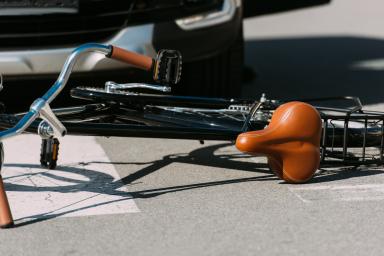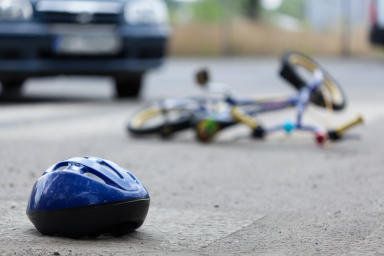Illinois Bicycle Laws

Illinois offers miles of bike lanes and trails to explore. The state’s largest city — Chicago — contains over 400 miles of paths and bikeways. The Prairie State is also home to the Grand Illinois Trail, which provides cyclists with views of the Mississippi River and Lake Michigan through a 535-mile loop. All these contribute to Illinois ranking 15th in the list of bicycle-friendly states by the League of American Bicyclists.
There are, of course, reasons why the ranking was low. In its 2022 report, the league gave a D grade to the state’s use of federal funding for bicycle infrastructure. Another probable reason was that the Illinois Department of Transportation recorded 33 bicycle-related fatalities in the same year. The number represented a 5.7% decrease from 2021, although it was 13% higher than 2020.
Accidents can and still occur despite programs that seek to improve cyclists’ safety. In the event of a crash, it is crucial that you are aware of your legal rights. This article contains information on Illinois’ damage caps and statute of limitations. It also has links to legal resources that can help you obtain the compensation you need.
Illinois Helmet Laws
Like motorcyclists, bicycle users do not need to wear helmets. No regulations for its use exist under Illinois law. However, there are certain municipalities that make it mandatory for some cyclists to use protective headgear. Chicago, home to more than a fifth of the state’s residents, requires bicyclists to use helmets.
Some villages and towns in Cook County make it compulsory for cyclists under a specific age to wear protective headgear. Barrington, Skokie, Inverness, and Cicero do not allow individuals under 16 to ride without helmets.
Does wearing helmets improve safety? National and state data seem to show that it does. Around 61% of bicyclists who died across the country in 2021 did not wear protective headgear. A separate study revealed that children in Illinois who wear helmets are less likely to sustain traumatic brain injuries from crashes compared to children who do not wear helmets.
The Illinois Secretary of State advises riders to use appropriate headgear and avoid injuries. The agency states in its manual that bicyclists should see the helmet’s front rim and feel it push down on their heads when they open their mouths wide.
On the other hand, the Chicago Department of Transportation recommends riders buy helmets that come with labels. These may come from various organizations, including the U.S. Consumer Products Safety Commission, the Snell Foundation, and the American Society for Testing and Materials.
Riders should be aware that penalties for not wearing helmets vary depending on the municipality. Chicago has a $25 penalty for bicycle messengers who violate the law. Nearby Barrington, however, imposes a fine of $50 for cyclists without helmets.
Sharing the Road in Illinois
The Prairie State does not allow bicyclists to travel across expressways and limited-access highways. Some cities have specific areas where riders can use their bikes. For example, Chicago has a 423.4-mile bike network. City residents should know that 49.7 miles of the network are marked as shared lanes. Bicyclists cannot ride in a different direction from the traffic on such roadways.
There are other prohibitions that Illinois riders should be aware of. The state makes it illegal for two cyclists to ride together on roadways. Cycling side-by-side is allowed only on exclusive bikeways. Riders should also travel in a single lane. However, when preparing to turn into a different lane or pass another vehicle, cyclists can travel across multiple lanes.
Another thing to consider is motorists getting out of their parked vehicles. A bicycle crash may occur if a rider does not avoid the door zone, which extends four feet from the parked cars.
Knowing how to share the road is critical for riders seeking to avoid accidents. Despite miles of protected lanes, collisions can still happen. Milwaukee Avenue, Chicago’s busiest cycling route, has seen over 50 accidents since 2020, three of which are fatal.
As part of their efforts to bring awareness about sharing the road, state authorities offer individuals Share the Road license plates. A portion of the proceeds goes to the state’s Share the Road Fund. The fund supports the mission of the nonprofit organization Ride Illinois, which is to educate motorists on how to share roadways safely.
Illinois E-Bike Laws
Illinois describes e-bikes as “electric bicycles” that run at low speeds. The state applies regulations to e-bike owners like those for traditional bicycle operators. Similar to the neighboring state of Missouri, Illinois classifies e-bikes into three types, which are:
Class 1: These e-bikes come with a motor that assists riders when they are pedaling. The motor disengages when the e-bike reaches a speed of 20 mph.
Class 2: These are e-bikes equipped with a motor and a throttle. The motor does not assist the rider when the e-bike achieves 20 mph.
Class 3: These are motor-equipped e-bikes that help riders when they are pedaling. The motor ceases to assist the cyclist when the e-bike reaches a speed of 28 mph.
E-bike users can use bike paths but cannot use sidewalks. The state also bans individuals under 16 from riding class 3 e-bikes. Individuals must check with their local municipalities on what routes bicycles are prohibited. For example, the City of Evanston bans cyclists from Ridge Avenue.
Individuals who use e-bikes should always be vigilant of their surroundings, as collisions may occur. In one case, an electric-assist Divvy user was killed by a car driver traveling through a yellow light. The accident happened on Chicago’s Near West Side.
Safe Following Distance in Illinois
Cyclists need to exercise caution around vehicles, especially trucks. ILSOS recommends that bicycle users wait behind turning vehicles. The agency also advises cyclists never to assume that drivers in front can see them.
The accident risk increases in cases where riders attempt to squeeze into the right side of a vehicle at intersections. Bike users should also completely stop before a school bus whose “STOP” sign is out.
Like Wisconsin, Illinois requires motorists to keep a safe distance — at least three feet — before passing cyclists. State law also allows drivers to overtake riders in no-passing zones if the latter moves less than half the posted speed.
IDOT encourages motorists to provide at least three to four seconds of distance between them and the vehicle in front. The agency recommends a higher following space — around five to six seconds — for motorists traveling at high speeds. A higher time should likewise be allotted when cycling at night.
Maintaining a safe following distance is one of the ways for motorists to reduce the risk of accidents, especially front-to-rear collisions, which accounted for 23.8% of all accidents in Chicago in 2021.
Illinois Bicycle Equipment Requirements
A front lamp that emits a white light visible for a minimum of 500 feet must be installed on bicycles. Another element that must be part of the bicycle is a red reflector or a lamp that emits red light. Riders should have these items at the bicycle’s rear and check that they can be seen from a distance between 100 and 600 feet.
There are two other bicycle components that cyclists need to possess before riding. State law requires bikes to come with reflex reflectors. These must be present on each pedal and noticeable from a distance of at least 200 feet. Another component is the side reflectors, which must be a minimum of 3/16 of an inch and can be seen from 500 feet.
These products make cyclists more visible to other motorists and help reduce the risk of accidents, especially during nighttime. According to an IDOT report, a significant number of crashes in Chicago occur during the afternoon, while around 38% of fatalities happen during the hours between midnight and 5 a.m.
Illinois Is a Fault State for Insurance Claims
The state follows the at-fault system. Unlike in Kentucky and Michigan, bicycle accident victims in Illinois can recover damages for their injuries from liable parties. They can also obtain compensation from the defendant’s insurer. In cases where the at-fault parties do not have insurance, plaintiffs may file claims with their insurance company, provided their policy has underinsured or uninsured motorist coverage. Such policies often apply to cases involving hit-and-run accidents.
Cyclists who are in some way responsible for accidents may use their homeowners’ insurance policies to compensate victims’ property damage or bodily injuries.
How Much Can Someone Sue for a Bicycle Accident in Illinois?
Illinois generally does not impose caps on the economic and noneconomic damages a plaintiff can receive from liable parties.
However, there are certain situations where a bicycle accident victim may only receive a limited amount of damages. For example, cyclists injured by a negligent state employee may only receive a maximum of $100,000 in damages. Plaintiffs should note that there are no caps on damages if the bicycle accident was caused by a state-owned vehicle.
Illinois also follows the collateral source rule. The state allows plaintiffs to recover full damages from the defendant regardless of whether the bicycle victim obtained compensation from third parties, like insurance companies.
What is Illinois’ Statute of Limitations for Bicycle Accidents?
Bicycle accident victims have two years from the date of the accident to file a lawsuit against liable parties. Those hurt — which may include cyclists, electric scooter users, pedestrians, and motorcycle operators — may press legal action against defendants within a two-year window.
In wrongful death cases, surviving family members or representatives of the deceased bicyclist may file a lawsuit within two years of the victim's death.
However, there are some cases where the two-year window does not apply. For instance, if a plaintiff is suing a defendant to recover bicycle repair costs, Illinois allows a maximum of five years for the victim to file a claim.
Legal Resources for Illinois Bicycle Accident Victims
Illinois Department of Transportation
Since 1971, IDOT has been designing, constructing, and maintaining transportation infrastructure across Illinois. The agency runs a website that contains various helpful information. These include a resource page where cyclists can find bike maps for different counties. It also funds organizations like Divvy, which offers bike-share programs primarily throughout Chicago. Cyclists seeking to report problems like pothole damage may do so through a call at (217) 782-6263, which is the number of the agency’s Central Bureau of Claims.
Illinois State Police
Since its inception as the Illinois Highway Maintenance Police in 1922, the agency has been working to improve public safety among residents and visitors in the state. It handles cases involving hit-and-run crashes and provides crash reports to victims. Bicyclists can obtain a copy of their crash report online or mail a request to the Patrol Records Unit’s address at 801 South 7th Street, Suite 600-M, Springfield, Illinois 62703.
Illinois Department of Insurance
The agency manages and enforces regulations from the Illinois Insurance Code. Part of its mission is to investigate complaints against insurance agents, public adjusters, and companies. The agency also maintains a website to educate cyclists about topics like terms related to their homeowners’ insurance policies. Bicycle users aiming to file reports against insurers may do so through an e-mail at DOI.Complaints@illinois.gov or a call at 866-445-5364.
Illinois State Bar Association
Since 1877, the association has been assisting lawyers in Illinois. It contains more than 28,000 members. It runs a Lawyer Referral Service that helps individuals with their cases. It has experience working with attorneys who are fluent in other languages. Bicyclists seeking legal assistance may call the association through their number at 800-922-8757. Individuals should note that the line is open Monday to Friday, from 9 a.m. to 3 p.m.
Expertise.com StaffAuthor
Step into the world of Expertise.com, your go-to hub for credible insights. We don't take accuracy lightly around here. Our squad of expert reviewers, each a maestro in their field, has given the green light to every single article you'll find. From rigorous fact-checking to meticulous evaluations of service providers, we've got it all covered. So feel free to dive in and explore. The information you'll uncover has been stamped with the seal of approval by our top-notch experts.




